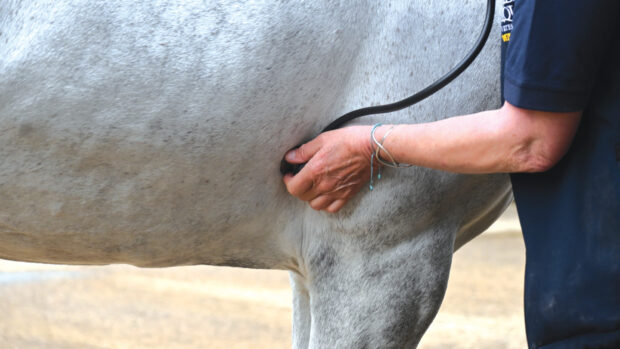The findings of a clinical trial could bring hope for owners of horses with osteoarthritis – with new treatment options on the horizon, possibly for humans as well as horses.
In a study published last month in a medical journal, Osteoarthritis and Cartilage Open Journal, researchers from the Swedish University of Agricultural Sciences and the University of Gothenburg tested the use of a new drug combination to treat horses with osteoarthritis-associated lameness, and the use of joint biomarkers that reflect the articular cartilage and bone remodelling to evaluate treatment efficacy.
The research involved 20 horses with osteoarthritis-associated lameness in the carpal joint. Ten horses were injected with the new drug combination – sildenafil (Viagra), anaesthetic mepivacaine and glucose – and the other 10 with a corticosteroid. In tests two weeks later, horses who had had the new combination became sounder faster, and samples of all the horses’ synovial fluid showed a “clear reduction” in biomarkers. In a follow-up interview 60 days later, the trainers said the horses were still sound.
Lead researcher and veterinary professor Eva Skiöldebrand told H&H the biomarkers were “significantly” reduced with the new treatment, indicating a slowing down of the disease. Although the control group, who were treated with corticosteroid, showed an improvement in their lameness after two treatments, six of the 10 showed an increase in biomarkers which may indicate a side effect by inducing cartilage degradation.
“Although the horses that received the corticosteroid were showing as pain free, there was a heavy degradation of the joint ongoing. This is something that can’t be seen by a vet examination, this is only possible to obtain if you have the biomarkers,” said Dr Skiöldebrand, adding that the use of steroids in general remains under debate in the veterinary world.
“Today, there are no disease-modifying drugs on the market, they only inhibit the clinical sign, the joint pain, they don’t slow down the disease. But in the horses that received the new drug, because of the reduction in biomarkers, we can say that this is a disease-modifying drug. The biomarkers are one tool in the toolbox, and then the drug combination a second. We can identify and diagnose at an early stage, treat and by looking at the biomarkers after treatment, we can say, ‘This has slowed down the disease progress.’”
The researchers are in discussions with a pharmaceutical company to produce a compounded version of the drug, which will be available via application to vets in Sweden, with hopes to then launch it in the UK and Australia. Dr Skiöldebrand added that owing to the genetic similarities between horses and humans, the team believe that the same drug compound could be effective for osteoarthritis in humans – and there are plans to conduct a clinical trial in the future.
Roger Smith, professor of equine orthopaedics at the Royal Veterinary College and president elect of British Equine Veterinary Association, told H&H the study is “interesting on a number of levels”. It followed a “rigorous blinded methodology to minimise bias” and used a drug combination not associated with the treatment of osteoarthritis – which included sildenafil, more commonly known as Viagra.
“Biomarkers have not yet gained widespread clinical use and yet potentially could hold the key to unlocking the biology of disease-modifying osteoarthritic drugs, in comparison to symptom-modifying drugs which are the most commonly used,” he said.
“To be convinced that such an unusual drug combination will work will differ depending on whether the reader is more interested in seeing a biological response and those only interested in knowing whether it makes horses sound.
“While there are some positive outcomes related to visual assessment of lameness and flexion test responses, the objective gait analysis shows no difference between the two treatments and at the third visit, the objective gait analysis values were lowest for the control group.
“Nevertheless, in the treatment of mild osteoarthritis, the ability to show a novel drug combination having an equivalent symptomatic effect as corticosteroids is not a disappointing result, with the added bonus of a biological effect within the joint from an unexpected direction – it may well put the spring back in the step of the lame horse.”
You might also be interested in:

Is age just a number? New study looks at when horses become ‘old’

Scientists aim to identify ‘spooky’ genes in new equine research

Subscribe to Horse & Hound magazine today – and enjoy unlimited website access all year round
Horse & Hound magazine, out every Thursday, is packed with all the latest news and reports, as well as interviews, specials, nostalgia, vet and training advice. Find how you can enjoy the magazine delivered to your door every week, plus options to upgrade your subscription to access our online service that brings you breaking news and reports as well as other benefits.




